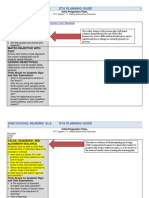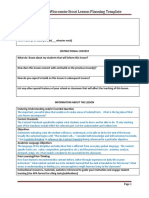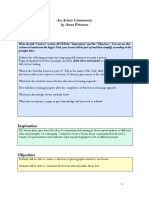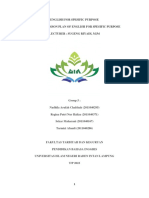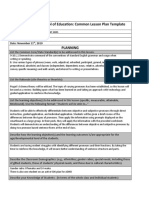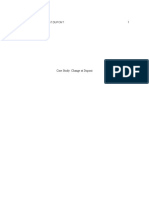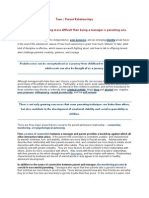UMU Lesson Plan Template: Caution It's For A Particular Type of Lesson Called An Advisory
UMU Lesson Plan Template: Caution It's For A Particular Type of Lesson Called An Advisory
Uploaded by
api-284273285Copyright:
Available Formats
UMU Lesson Plan Template: Caution It's For A Particular Type of Lesson Called An Advisory
UMU Lesson Plan Template: Caution It's For A Particular Type of Lesson Called An Advisory
Uploaded by
api-284273285Original Title
Copyright
Available Formats
Share this document
Did you find this document useful?
Is this content inappropriate?
Copyright:
Available Formats
UMU Lesson Plan Template: Caution It's For A Particular Type of Lesson Called An Advisory
UMU Lesson Plan Template: Caution It's For A Particular Type of Lesson Called An Advisory
Uploaded by
api-284273285Copyright:
Available Formats
UMU Lesson Plan Template
(redesigned to fit EDU 150 Lesson Plan including some Planning Commentary PROMPTS)
For additional insight into writing a lesson plan, watch the YouTube video.
https://www.youtube.com/watch?v=BZCLhjInoSwhttps://www.youtube.com/watch?
v=BZCLhjInoSw Caution its for a particular type of lesson called an Advisory
Lesson, but it should help you understand elements to consider when designing
a lesson.
Name: Mitchell Ray & Steven Scott
Date: Monday April 13, 2015
Grade Level: Freshman
Class Period: EDU SECTION 2
Subject: English
Lesson # & Title: Lesson 4 Writing
Big Idea/Lesson Focus: Writing/Creative Writing
Essential Question: How important is WRITING?
Context for Learning: This lesson is designed for 23 to 28 college-age students enrolled in a
Foundations of Education (introductory) class. Their interests vary widely, but have teaching
interests re: PK-3, 4-9, 7-12 and Multi-age classrooms. The college students are designing and then
teaching their first lesson for EDU 150. It should be interesting. Collectively the class is comprised
of typical 18-22 yr. olds. There are some student athletes as well as academic leaders and young
men and women with other leadership duties on campus. This lesson derives from topics covered
in Teach Like Your Hairs on Fire by Rafe Esquith. Topics range from Literacy to Problem-solving.
.
Function of the Lesson (check all that apply):
Introduce New Skill
Review
Advisory Lesson
Remediation/Reteach
or Content
Practice
ing
Content Standards:ThisisunnecessaryforthisEDU150LessonPlan.However,inlessonsthatyoull
designforK12schools,CONTENTSTANDARDSwillcomefromtheODEWebsite
http://education.ohio.gov/Topics/OhiosNewLearningStandardsorCommonCoreStandards
http://www.corestandards.org/.TheContentStandardsarethebroaderacademicstandardsintowhichthe lesson
fits. You may cut and paste them directly from the ODE or Common Core Websites
Learning Objectives: Following our lesson, we intend for students to understand
the purpose of writing and creative writing in a classroom.
Academic Language (or A.L. Demands, A.L. Objectives): Intrapersonal and
Llinguistic Two examples of Howard Gardners Multiple Intelligences (definitions on PPT
slide)
Instructional Materials and Support: Given reading, Example of Mitchs creative writing.
Prior Knowledge: We would understand what we are talking about due to what
we have learned in prior education and from the reading.
Assessments:
(For this lesson you will only need to do a short Pre-Assessment find out about their Prior
Knowledge and then a Post-assessment to determine if the students met your objective.
Pre-Assessment for the unit: Brain teasers. We noticed that the fellow students
had done writing before, but creative writing might have been a new idea to them.
Assessment(s) during the lesson: Only assess what was taught
Assessment(s) at the end of the lesson: Clear up misconceptions
Post-Assessment for the unit: Round Robin
Strategies & Learning Tasks
Introduction: Brain Teasers and what you will learn
Presentation/Explicit Instruction: (I do! [the teacher]) Introduction and activities
Structured Practice/Exploration: (We do! [with the teacher doing more than the students.])
Describing book reports/essays and creative writing works that Steven and Mitchell have
done before.
Guided Practice/Specific Feedback : (We do! [with the students doing more than the
teacher]) Questions has anyone ever created a creative writing piece? What could creative
writing do to a childs mind?
Independent Practice/Application: (You do! [Its all students doing at this point.])
HOMEWORK ASSIGNMENT Creative Writing assignment for EDU 150 bonus points. ROUND
ROBIN STORY Give students chance to open up their creative side a little bit.
Closure: Homework assignment is meant to let students see how writing can be used for
them individually.
Differentiation, Individualized Instruction, and Assessment: (This is unneeded with
EDU 150, but with PK-12 you will need to anticipate how you would differentiate instruction
based on individual needs and exceptionalities. )
Research and Theory: Howard Gardners Multiple Intelligences
For additional insight into writing a lesson plan, watch this YouTube video.
https://www.youtube.com/watch?v=BZCLhjInoSwhttps://www.youtube.com/watch?
v=BZCLhjInoSw
Here are the edTPA prompts that you will answer for edTPAs
Planning Commentary that will accompany the lesson plans that you
complete during your Methods classes, Pre-clinical, and Clinical
Practice. For this lesson, you only need to answer the bolded
prompts -1 (Content Focus) and 2a (Knowledge of Students to
inform Teaching - Academic Language Development). Please read
the other prompts and be aware that when you design lessons for
courses in other courses.
1. Content Focus for the Advisory Lesson. The summary can be holistic
covering the lesson, but be sure to show how the lesson would connect to
any lessons that come before and after this lesson!
Content Focus Summarize the central focus for the content you will
teach in this learning segment.
Explain how this focus allows your students to ask and answer significant
and challenging questions about their world and to make relevant,
interdisciplinary connections.
2. Knowledge of Students to Inform Teaching
a.
Academic language development (e.g., students abilities to
understand and produce the oral or written language associated with the
central focus and standards/objectives within the learning segment)
b.
Young adolescent development, including cognitive, physical, and social and
emotional dimensions
3. Supporting Young Adolescent Learning in the Discipline
Be sure to cite research and theory, including concepts addressing young adolescent
learning, to support your explanations.
a.
How are the plans for instruction sequenced in the learning segment to build
connections between students prior learning and experiences and new knowledge?
b.
Explain how, throughout the learning segment, you will help students make
connections between and among facts, concepts, interpretations, and claims/arguments
regarding your content area.
c.
Describe any instructional strategies planned to support young adolescents with
specific learning needs. This will vary based on what you know about your students but may
include students with individualized education programs (IEPs), English language learners, or
gifted students needing greater support or challenge.
4. Supporting Student Understanding and Use of Academic Language
Respond to the prompts below to explain how your plans support your students academic
language development.
a.
Identify the key academic language demand and explain why it is integral to the
central focus for the segment and appropriate to students academic language
development. Consider language functions and language forms, essential vocabulary,
symbols, and/or phrases for the concepts and skills being taught, and instructional language
necessary for students to understand or produce oral and/or written language within
learning tasks and activities.
5. Monitoring Student Learning
a.
Explain how the informal and formal assessments were selected and/or designed to
provide evidence you will use to monitor student progress toward the standards/objectives.
Consider how the assessments will provide evidence of students understanding of facts,
concepts, interpretations, and analyses to make and explain claims/arguments about a
significant historical event or social studies phenomenon.
b.
Describe any modifications or accommodations to the planned assessment tools or
procedures that allow young adolescents with specific needs to demonstrate their learning.
You might also like
- Post-Test 1 - Planning and Organizing Competency AssessmentDocument5 pagesPost-Test 1 - Planning and Organizing Competency AssessmentJude Metante100% (1)
- HABC Level 3 International Award in Delivering TrainingDocument2 pagesHABC Level 3 International Award in Delivering TrainingMusharaf ShahNo ratings yet
- Lesson Plan Template: StandardsDocument4 pagesLesson Plan Template: Standardsapi-314451408No ratings yet
- Work Lesson PlanDocument6 pagesWork Lesson Planapi-310504510No ratings yet
- The Multicultural Lesson PlanDocument2 pagesThe Multicultural Lesson Planapi-516586218No ratings yet
- Assessment 1: Essay On The Foundation of Teaching and LearningDocument10 pagesAssessment 1: Essay On The Foundation of Teaching and Learningapi-408498483No ratings yet
- Edu 150 Lesson PlanDocument4 pagesEdu 150 Lesson Planapi-314694819No ratings yet
- Linguistic Lesson Plan Guidelines and Template - Rev Apr 18Document5 pagesLinguistic Lesson Plan Guidelines and Template - Rev Apr 18Jessica PulidoNo ratings yet
- Effective Lesson Planning: Standard Competency Training 2019-2020Document31 pagesEffective Lesson Planning: Standard Competency Training 2019-2020Fivie EmdiNo ratings yet
- Activity4 Powerpoint Presentation 1Document20 pagesActivity4 Powerpoint Presentation 1Jane DVNo ratings yet
- Lesson Plan TemplateDocument6 pagesLesson Plan Templaterochelle.keebleNo ratings yet
- Faith Lesson Plan JagDocument2 pagesFaith Lesson Plan Jagapi-508417868No ratings yet
- Jordan Casteel Lesson SketchDocument8 pagesJordan Casteel Lesson Sketchapi-530577431No ratings yet
- USW1 EDUC 3056 Elementary Education Lesson Plan TemplateDocument6 pagesUSW1 EDUC 3056 Elementary Education Lesson Plan TemplateRoopa NatarajNo ratings yet
- Lesson Plan Template 7 NSCrawfordDocument3 pagesLesson Plan Template 7 NSCrawfordjcrawfordc19No ratings yet
- Rela Dta Manipulatable Template Lesson Planner-InclusionDocument10 pagesRela Dta Manipulatable Template Lesson Planner-Inclusionapi-289256048No ratings yet
- Sample Lesson Plan RubricDocument2 pagesSample Lesson Plan RubricBianca SegerNo ratings yet
- Eapp Module 2Document26 pagesEapp Module 2Jasmine Marie ArjinalNo ratings yet
- EAPP Module 4Document27 pagesEAPP Module 4CHERRY ANN OLAJAY100% (1)
- Lesson Plan Vita Visit Village 2013 - Teaching Activity: Group: Date: Lesson Topic: Grade: Supervising TeacherDocument3 pagesLesson Plan Vita Visit Village 2013 - Teaching Activity: Group: Date: Lesson Topic: Grade: Supervising TeacherSatria Andy KiranaNo ratings yet
- Pitp 3 Mod 3Document4 pagesPitp 3 Mod 3api-285316194No ratings yet
- Lesson Template (edTPA Aligned)Document3 pagesLesson Template (edTPA Aligned)bbrossardNo ratings yet
- Copia de HOW TO CREATE AN EFFECTIVE LESSON PLANDocument25 pagesCopia de HOW TO CREATE AN EFFECTIVE LESSON PLANRosamiguelina28No ratings yet
- Lesson Plan - Integrating QuotesDocument4 pagesLesson Plan - Integrating Quotesapi-198001799No ratings yet
- Planning TemplatesDocument8 pagesPlanning TemplatescrossroadsqueenNo ratings yet
- Ochia - Unit 2 - Lesson 1-Development LessonDocument4 pagesOchia - Unit 2 - Lesson 1-Development LessonKen Vincent OchiaNo ratings yet
- ESP 2 Final Term Exam (Valdo Varelleo Zulla 1619500066)Document12 pagesESP 2 Final Term Exam (Valdo Varelleo Zulla 1619500066)Takasu ryuujiNo ratings yet
- Activity4 Powerpoint Presentation .....Document21 pagesActivity4 Powerpoint Presentation .....Jane DVNo ratings yet
- Lesson PlanningDocument4 pagesLesson PlanningMarielAbaloNo ratings yet
- Week 6 Planning To Teach (Formats of Lesson Plan)Document43 pagesWeek 6 Planning To Teach (Formats of Lesson Plan)Joyce Voon Ern CzeNo ratings yet
- Catherine Opie Lesson SketchDocument8 pagesCatherine Opie Lesson Sketchapi-530577431No ratings yet
- Write A Lesson Plan GuideDocument6 pagesWrite A Lesson Plan Guidefrieda20093835No ratings yet
- ESL Practicum Lesson PlanDocument6 pagesESL Practicum Lesson Planapi-404665962No ratings yet
- What Does A Lesson Plan Include?Document5 pagesWhat Does A Lesson Plan Include?Thulasi Raman KowsiganNo ratings yet
- Episode 10Document14 pagesEpisode 10PRESIDENT GAMINGNo ratings yet
- Educational Technology 1 Chapter 6 ReportDocument13 pagesEducational Technology 1 Chapter 6 ReportHarly DavidsonNo ratings yet
- FS Eps 10Document12 pagesFS Eps 10Clarice Anne GeolinNo ratings yet
- EL 103 Instructional Learning GuideDocument100 pagesEL 103 Instructional Learning Guideangelsanda2000100% (1)
- Reflective Lesson Plan (Idioms)Document7 pagesReflective Lesson Plan (Idioms)rpaige14No ratings yet
- Edtp 4302 A&eDocument6 pagesEdtp 4302 A&eAshley HernandezNo ratings yet
- IDEA Course OutlineDocument3 pagesIDEA Course OutlineJenby Grace SomeraNo ratings yet
- Boppps DetailDocument10 pagesBoppps DetailMUHAMMAD SAYYIDNo ratings yet
- Target Your Intended Learning OutcomesDocument12 pagesTarget Your Intended Learning OutcomesVincent Barugo ReofrioNo ratings yet
- Why Is The English Language Curriculum Changing?Document7 pagesWhy Is The English Language Curriculum Changing?Milla MahaliNo ratings yet
- CommonlessonplanDocument2 pagesCommonlessonplanapi-212401080No ratings yet
- Lesson Planning: Boylen B. CabagDocument11 pagesLesson Planning: Boylen B. CabagCharles Vincent PaniamoganNo ratings yet
- Lesson Plan Format For Teacher Education Candidates Ithaca College School of Humanities and SciencesDocument3 pagesLesson Plan Format For Teacher Education Candidates Ithaca College School of Humanities and Sciencesapi-285942234No ratings yet
- Coe Lesson Plan TemplateDocument7 pagesCoe Lesson Plan TemplateErica Hardnett AnthonyNo ratings yet
- Crawford Task1 LPDocument12 pagesCrawford Task1 LPapi-327039356No ratings yet
- Lesson Plan TemplateDocument2 pagesLesson Plan Templatebiffin100% (1)
- LESSON PLANNING,STRATEGIES FOR INTERACRTIVE LEARNING,NIBNE EVENTS FOR INSTRUCTION,DESIGNING ASSESSMENTDocument11 pagesLESSON PLANNING,STRATEGIES FOR INTERACRTIVE LEARNING,NIBNE EVENTS FOR INSTRUCTION,DESIGNING ASSESSMENTAkal MorrisNo ratings yet
- Template Rubric For Science Lesson Plan2013 28individuals29Document6 pagesTemplate Rubric For Science Lesson Plan2013 28individuals29api-234440813No ratings yet
- Episode 10Document11 pagesEpisode 10Jerome RodriguezNo ratings yet
- GCU Lesson Plan TemplateDocument7 pagesGCU Lesson Plan TemplateKeyania MurrayNo ratings yet
- Module 4.2 - Lesson Stages and PlanDocument19 pagesModule 4.2 - Lesson Stages and PlanThuonggipNo ratings yet
- Makalah Kel.5 ESPDocument17 pagesMakalah Kel.5 ESPOzieNo ratings yet
- Lesson Plan For SophomoresDocument5 pagesLesson Plan For SophomoresKaitlynn LoosNo ratings yet
- Myp Lesson Plan Template With First Nation Principles of Learning IntergrationDocument4 pagesMyp Lesson Plan Template With First Nation Principles of Learning Intergrationapi-292000448No ratings yet
- Lesson Planning and Use of Resources For Language TeachingDocument8 pagesLesson Planning and Use of Resources For Language TeachingAmiraNo ratings yet
- EFL Toolkit For TeachersDocument56 pagesEFL Toolkit For TeachersAbuZaydNo ratings yet
- Harding Da Rosa 2018 Promoting Project-Based Learning Q&ADocument7 pagesHarding Da Rosa 2018 Promoting Project-Based Learning Q&Ajasonanderson1No ratings yet
- Reflective Lesson Plan (Context Clues)Document6 pagesReflective Lesson Plan (Context Clues)rpaige14No ratings yet
- Principles of People Management ILM Assessment For Knowledge Units (ML24)Document19 pagesPrinciples of People Management ILM Assessment For Knowledge Units (ML24)omedNo ratings yet
- Religion and Spirituality in Psychotherapy: A Practice-Friendly Review of ResearchDocument17 pagesReligion and Spirituality in Psychotherapy: A Practice-Friendly Review of ResearchJuan Gabriel Vargas JaramilloNo ratings yet
- Alternative AssessmentDocument16 pagesAlternative AssessmentHarold JohnNo ratings yet
- Assessment 1 PresentationDocument14 pagesAssessment 1 Presentationapi-253529065No ratings yet
- Choice BoardDocument2 pagesChoice Boardapi-317273644No ratings yet
- Cabin Fever Symptoms and Coping Skills PDFDocument4 pagesCabin Fever Symptoms and Coping Skills PDFNISAR_786No ratings yet
- Disruptive Behavioral DisorderDocument5 pagesDisruptive Behavioral Disorderapi-228136529100% (1)
- Psiii Professional Goals - Yosev SantosDocument2 pagesPsiii Professional Goals - Yosev Santosapi-501380321No ratings yet
- Case Study - Change at Dupont 2Document5 pagesCase Study - Change at Dupont 2peteredis0% (1)
- MichaelPage - Salary Table HR 2024Document2 pagesMichaelPage - Salary Table HR 2024formfit.frNo ratings yet
- Daily Lesson Log in Tle 8: Day 1 Day 2 Day 3 Day 4Document3 pagesDaily Lesson Log in Tle 8: Day 1 Day 2 Day 3 Day 4Modesto ValdrizNo ratings yet
- Attitudes and Job Satisfaction: © 2007 Prentice Hall Inc. All Rights ReservedDocument15 pagesAttitudes and Job Satisfaction: © 2007 Prentice Hall Inc. All Rights ReservedElearnNo ratings yet
- Project Grading RubricDocument2 pagesProject Grading RubricHarry JinNo ratings yet
- Tell Me About Yourself?: What Are Your Strengths?Document3 pagesTell Me About Yourself?: What Are Your Strengths?Cristian David Vargas MejiaNo ratings yet
- Content Knowledge Lesson PlanDocument3 pagesContent Knowledge Lesson PlanKevin PottsNo ratings yet
- Perdev Lesson 2Document43 pagesPerdev Lesson 2D GarciaNo ratings yet
- Press Release - The 4th HR Conclave and The 2nd DMA-Thomas International Awards in HRDocument2 pagesPress Release - The 4th HR Conclave and The 2nd DMA-Thomas International Awards in HRsachinthomas123100% (1)
- Tokoh CBTDocument5 pagesTokoh CBTrara.01No ratings yet
- GRADES 1 To 12 Daily Lesson Log JUNE 3-7, 2019 (WEEK 1) Monday Tuesday Wednesday Thursday FridayDocument4 pagesGRADES 1 To 12 Daily Lesson Log JUNE 3-7, 2019 (WEEK 1) Monday Tuesday Wednesday Thursday FridayEllah Franzien Dutillos EderNo ratings yet
- Department of Education: Homeroom Guidance OrientationDocument2 pagesDepartment of Education: Homeroom Guidance OrientationGlenda FernandoNo ratings yet
- The Role of Educational Psychology in Today'S Technology Enriched ClassroomDocument7 pagesThe Role of Educational Psychology in Today'S Technology Enriched ClassroomCamille AldayNo ratings yet
- Different Leadership Styles and Their Advantages and DisadvantagesDocument2 pagesDifferent Leadership Styles and Their Advantages and DisadvantagesAqmarinaNo ratings yet
- Activity Educational LeadershipDocument2 pagesActivity Educational Leadershipcherkarlo100% (1)
- rdg323 Graphic Organizer 10 24 20Document3 pagesrdg323 Graphic Organizer 10 24 20api-488370622No ratings yet
- Parent Teen RelationshipDocument2 pagesParent Teen RelationshipNeeraj RathoreNo ratings yet
- Competency Management - Class Notes HRM 2018-20Document18 pagesCompetency Management - Class Notes HRM 2018-20Rahul Raj0% (1)
- Under The Process of Revision)Document8 pagesUnder The Process of Revision)maria esperanza quilaNo ratings yet















